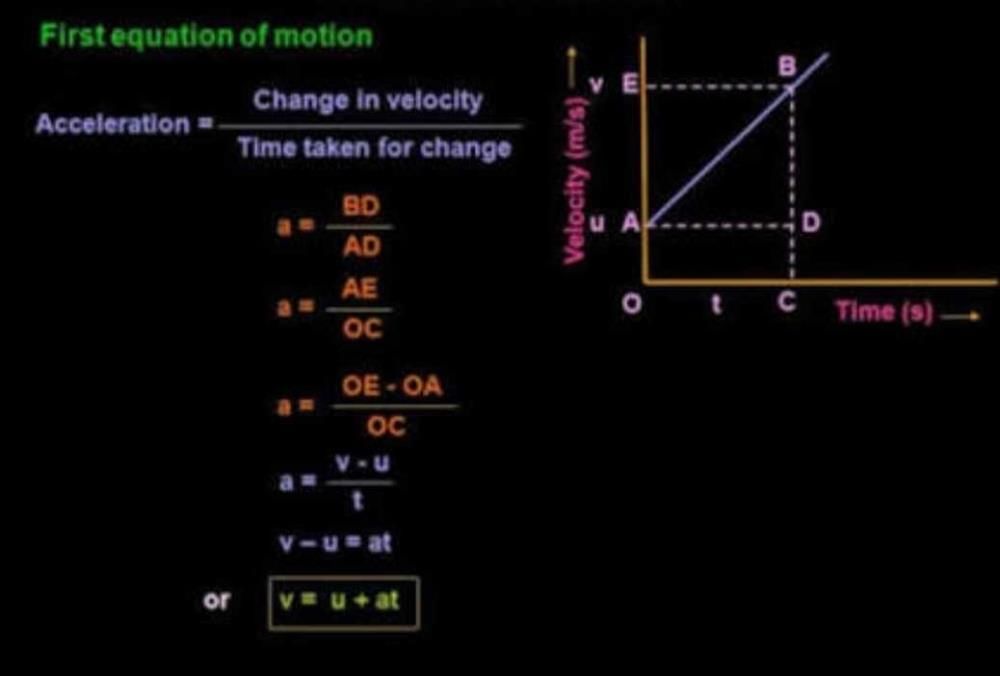Class 9 Exam > Class 9 Questions > what is the graphical derivation of first equ...
Start Learning for Free
what is the graphical derivation of first equation of motion🤔?
Most Upvoted Answer
what is the graphical derivation of first equation of motion🤔?

Community Answer
what is the graphical derivation of first equation of motion🤔?
Graphical Derivation of First Equation of Motion
The first equation of motion can be derived graphically by analyzing the velocity-time graph of an object in motion.
Key Steps:
- Start by plotting a velocity-time graph with time on the x-axis and velocity on the y-axis.
- The slope of the graph represents the acceleration of the object.
- The area under the graph represents the displacement of the object.
Explanation:
- Initially, the object is at rest with a velocity of 0 m/s.
- As time progresses, the velocity of the object increases linearly with time, indicating a constant acceleration.
- The slope of the graph gives the acceleration, which is constant in this case.
- The equation of motion can be derived from the slope of the graph, which gives the acceleration as a function of time.
By analyzing the velocity-time graph, we can derive the first equation of motion which relates initial velocity, acceleration, time, and displacement of an object in motion. This graphical derivation provides a visual representation of the relationship between velocity, time, and displacement, helping us understand the motion of objects more intuitively.
The first equation of motion can be derived graphically by analyzing the velocity-time graph of an object in motion.
Key Steps:
- Start by plotting a velocity-time graph with time on the x-axis and velocity on the y-axis.
- The slope of the graph represents the acceleration of the object.
- The area under the graph represents the displacement of the object.
Explanation:
- Initially, the object is at rest with a velocity of 0 m/s.
- As time progresses, the velocity of the object increases linearly with time, indicating a constant acceleration.
- The slope of the graph gives the acceleration, which is constant in this case.
- The equation of motion can be derived from the slope of the graph, which gives the acceleration as a function of time.
By analyzing the velocity-time graph, we can derive the first equation of motion which relates initial velocity, acceleration, time, and displacement of an object in motion. This graphical derivation provides a visual representation of the relationship between velocity, time, and displacement, helping us understand the motion of objects more intuitively.

|
Explore Courses for Class 9 exam
|

|
Similar Class 9 Doubts
Question Description
what is the graphical derivation of first equation of motion🤔? for Class 9 2025 is part of Class 9 preparation. The Question and answers have been prepared according to the Class 9 exam syllabus. Information about what is the graphical derivation of first equation of motion🤔? covers all topics & solutions for Class 9 2025 Exam. Find important definitions, questions, meanings, examples, exercises and tests below for what is the graphical derivation of first equation of motion🤔?.
what is the graphical derivation of first equation of motion🤔? for Class 9 2025 is part of Class 9 preparation. The Question and answers have been prepared according to the Class 9 exam syllabus. Information about what is the graphical derivation of first equation of motion🤔? covers all topics & solutions for Class 9 2025 Exam. Find important definitions, questions, meanings, examples, exercises and tests below for what is the graphical derivation of first equation of motion🤔?.
Solutions for what is the graphical derivation of first equation of motion🤔? in English & in Hindi are available as part of our courses for Class 9.
Download more important topics, notes, lectures and mock test series for Class 9 Exam by signing up for free.
Here you can find the meaning of what is the graphical derivation of first equation of motion🤔? defined & explained in the simplest way possible. Besides giving the explanation of
what is the graphical derivation of first equation of motion🤔?, a detailed solution for what is the graphical derivation of first equation of motion🤔? has been provided alongside types of what is the graphical derivation of first equation of motion🤔? theory, EduRev gives you an
ample number of questions to practice what is the graphical derivation of first equation of motion🤔? tests, examples and also practice Class 9 tests.

|
Explore Courses for Class 9 exam
|

|
Signup to solve all Doubts
Signup to see your scores go up within 7 days! Learn & Practice with 1000+ FREE Notes, Videos & Tests.





















